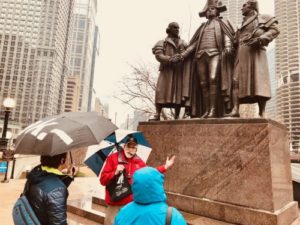By Brent Hoffmann, Class of 2005

When he retired in 2010, Bob Michaelson says, “I realized that I’d go crazy if I didn’t have an outside activity.” Until then, Bob had an active career as a chemist and college librarian. Now he’s hyperactive — as a docent with CAC, Glessner House, and the Charnley-Persky House.
Bob earned a B.S. in chemistry at the University of Chicago. Then he went to Yale for a Ph.D. in chemistry, focusing on spectroscopy, physical chemistry, and photochemistry. He followed up with a year-long, post-graduate position as a chemist at the University of Prince Edward Island in Charlottetown, on Canada’s Prince Edward Island. He relocated to the University of Chicago for an M.A. in library science, followed by a year as chemistry librarian at Syracuse University. After returning to Yale, Bob served as a librarian for five years at the university’s science library, then moved to Evanston to head up the Seeley G. Mudd Library for Science and Engineering at Northwestern University. “I switched from chemistry to library science because I really wasn’t creative enough to be a serious chemist, but I wanted to remain in academe,” explains Bob.
Certified for 8 Tours
Bob became a CAF docent in 2011. “I’d always enjoyed Chicago and its architectural history,” he says. He’s certified to lead the Building Blocks of Architecture, Chicago Architecture: A Walk Through Time, Chicago: City of Architecture, Chicago Icons: Connecting Past & Present, Evanston Along the Lake, Historic Skyscrapers, Science of Architecture, and the University of Chicago Campus tours. “I most like the University of Chicago Campus tour because I’ve known the campus for such a long time. I can tell stories and answer questions about even very obscure aspects of it.”
His tourees, as well as fellow docents, enjoy Bob’s dry sense of humor. At six-foot-three inches, he stands out among his peers. “Ever since I was a teenager, people have asked me if I played basketball,” he says. “No, I don’t play a sport, because I’ve always kind of been kind of clumsy.”
Picasso in the Windy City
“When leading tours, I like to tell stories. Factual stories,” he insists — often based on his own research of primary sources. At the Picasso sculpture on the Daley Plaza, he summarizes a story told by the daughter of Fazlur Khan, who oversaw the engineering of the full-size sculpture: “Based on Picasso’s small model, it was calculated that the full-size sculpture wouldn’t be sturdy enough to withstand the fierce winds of Chicago. So changes had to be made to Picasso’s design. The job fell to a young engineer, Joe Calaco, who strengthened the design by specifying thicker sheets of steel. He added stiffener plates for connections to the steel surfaces, and made other changes to beef-up the sculpture. But the architect who oversaw the project didn’t like those changes. He told Calaco that he was fired. But Calaco’s boss, Khan, told him not to worry and to complete his work. In the summer of 1966, the revamped model – with Calaco’s and Khan’s changes — was taken to France for the great artist’s approval. Picasso placed the new model next to his original model. And he said, ‘I think it’s really fantastic, don’t you? In fact, I’d go so far as to say it’s better than my original’.”
Glessner & Charnley, Too
At the end of his docent training in 2011, Bob and his classmates celebrated with a bus tour that included a stop at Glessner House. “I found Glessner to be very interesting, as a great example of historic preservation,” he says. “Of course, its preservation was also the origin of what is now the CAC. It was one of Richardson’s last works and an inspiration to Louis Sullivan and Frank Lloyd Wright. Later I saw a note online asking for volunteers at the house. I applied, became a Glessner docent, and lead at least 24 hours of tours a year.”
In 20ll, during his first year as a CAF docent, he visited the Sullivan and FLW-designed Charnley-Persky House on North Astor Street. Says Bob, “It’s a pivotal work of modern architecture as well as the headquarters of the Society of Architectural Historians. Wright called it ‘the first modern house built in America.’ Charnley shows the transformation of Victorian residential architecture to the modern era. I particularly like Sullivan’s decorative plant forms combined with Wright’s geometric designs — and the amazing atrium you encounter as you walk inside.” Bob leads about 12 Charnley-Persky tours throughout the year.
“As a docent at three architecture organizations, I have more than enough activities to avoid going crazy from inactivity,” concludes Bob.




Great article and inspiration about how to spend a productive and rewarding retirement from paid work. Glad I recruited him for the Evanston tour early on!
Norma Green
Great article about Bob. Proud he was in our class of 2011. We all always depend on him for the definitive answer to our architectural questions. He is agreat resourse and such a wo derfulguy. Thanks Brett for highlighting him. Barbara Weiner